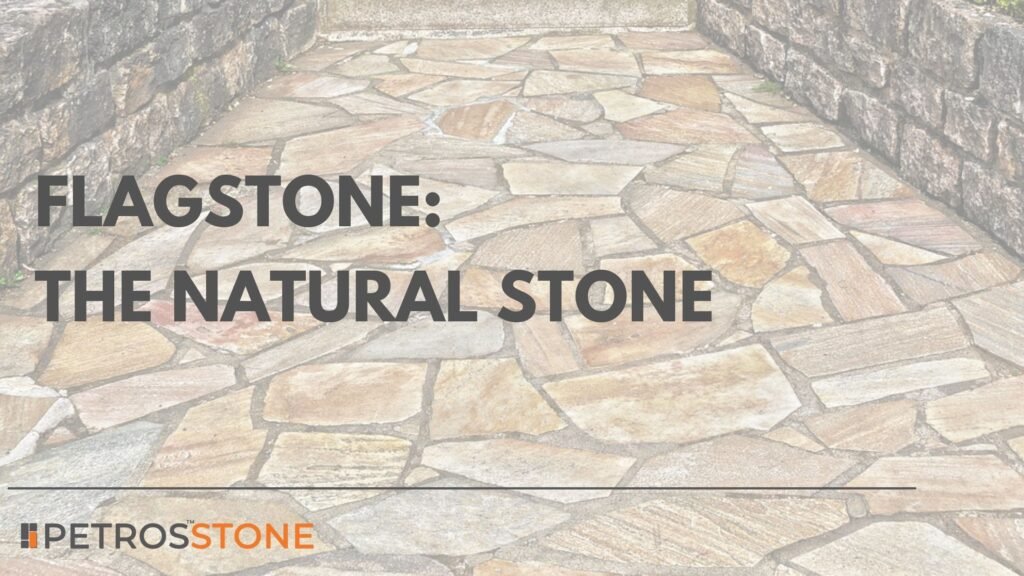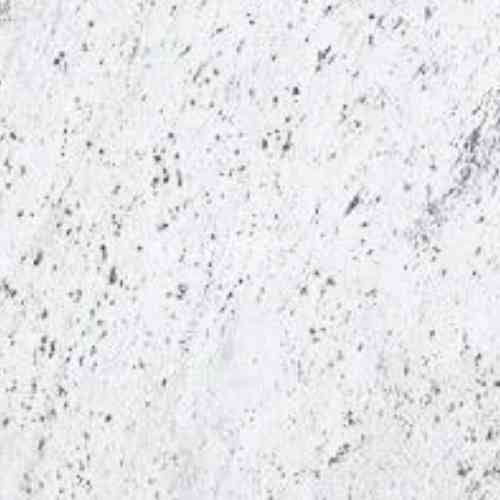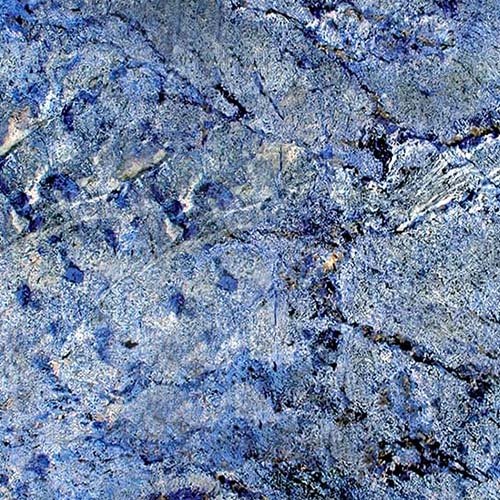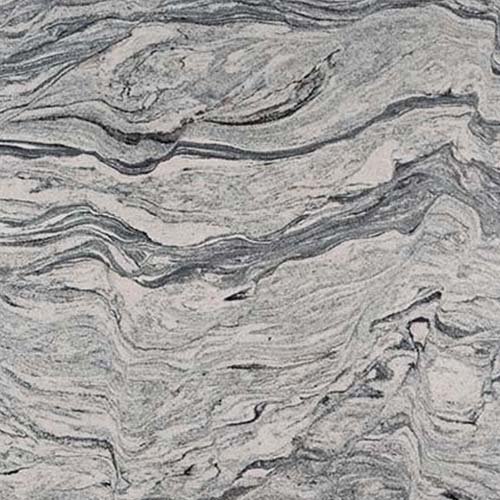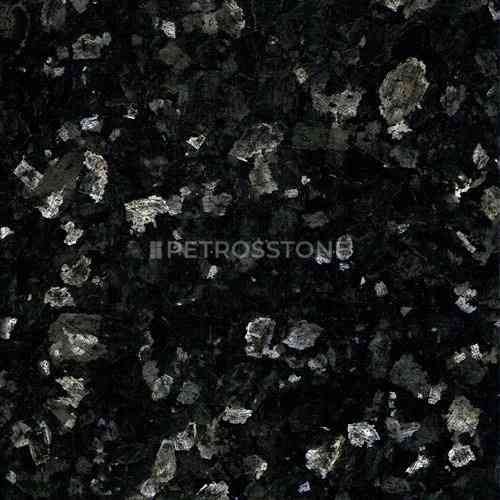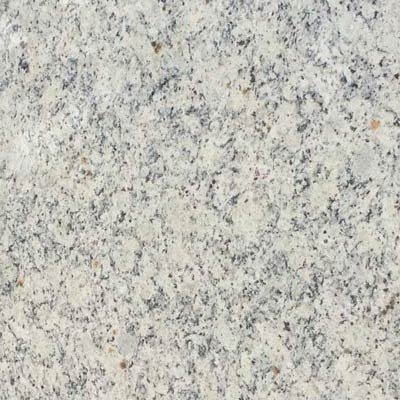
Did you ever notice a rugged stone pathway or a rustic patio floor and wonder what gives it that timeless, weathered charm? Most likely, you were looking at flagstone, a natural quarried stone beloved for its organic look, durability, and versatility. Whether it’s an old-world European courtyard or a modern terrace, flagstone has remained a staple in outdoor design for centuries.
Flagstone brings unmatched natural appeal to patios, walkways, garden paths, pool decks, and courtyards. Its irregular shapes, earthy tones, and textured surfaces create a sense of permanence and artistry that artificial tiles can’t replicate. It’s no surprise that homeowners, landscape designers, and architects continue to choose it for both rustic and contemporary spaces.
Flagstone Cost Breakdown (USD per sq. ft.)
| Category | Details | Approx. Cost (USD / sq. ft.) |
|---|---|---|
| Basic Flagstone | Sandstone (Raj Green, Kandla Grey), Limestone (Kota, Tandur) | $0.60 – $1.20 |
| Premium Flagstone | Granite, Quartzite, High-quality Slate | $1.08 – $1.80 |
| Imported/Exotic | Travertine, Imported Slate, Rare Stones | $2.40+ |
| Labor – Dry-laid | Placed on sand/gravel bed, basic fitting | $0.60 – $1.20 |
| Labor – Mortar-set | Cement base, joints, skilled masonry | $1.20 – $1.80+ |
Total Project Cost Range (Material + Labor)
| Project Range | Scenario | All-in Cost (USD per sq. ft.) | Example (100 sq. ft. Patio) |
| Budget | Local stone + dry-laid install | $1.44 – $1.80 | $144 – $180 |
| Mid-range | Better stone + mortar set | $2.40 – $3.60 | $240 – $360 |
| High-end | Imported/expensive stone + intricate work | $3.60+ | $360+ |
In this article, we explore what flagstone is, its most popular laying patterns, and standard slab sizes. You’ll discover creative design ideas, practical installation methods with cost insights, and essential maintenance tips. We also highlight common mistakes to avoid, so you can build a durable, beautiful flagstone patio or walkway with confidence.
What Is Flagstone?
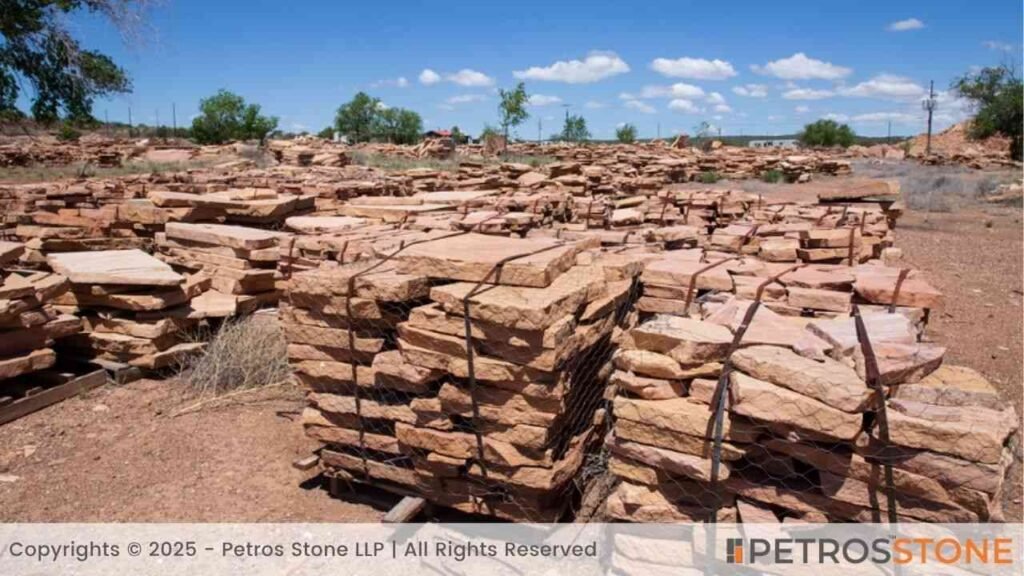
‘Flagstone’ is not a specific rock; flat stone slabs used in paving and landscaping are commonly referred to by this generic term. The majority of flagstones tend to be sedimentary rocks (typically sandstone) that naturally split into thin layers, which makes them suitable for walkways, patios, floors, and roofing. Flagstone is strong and has distinctive colors due to the presence of quartz and feldspar bonded by calcite or silica.
Indian sandstone is renowned for its rich earthy tones, such as Kandla grey, Raj green, and autumn brown, and it constitutes a significant portion of the flagstone used in India and exported worldwide. Across the globe, construction projects use local limestone, such as Kota or Tandur stone, and slate as flagstone.
What is the reason behind the love for flagstone among people? Natural beauty and durability. The organic, natural shapes and somewhat uneven surfaces impart a rustic, earthy appeal that brick or concrete pavers frequently lack. The textured surface of flagstones makes them naturally slip-resistant, which is an advantage for outdoor applications. They have been utilized for hundreds of years, from medieval castle floors to contemporary gardens, demonstrating their longstanding appeal.
Popular Patterns for Patios and Walkways
The patterns you can lay flagstone in are one of the joys of the material. Whether you want a loose natural look or a structured design, flagstone has you covered. The following are some popular patterns for patios and walkways:
Irregular (Crazy Paving)
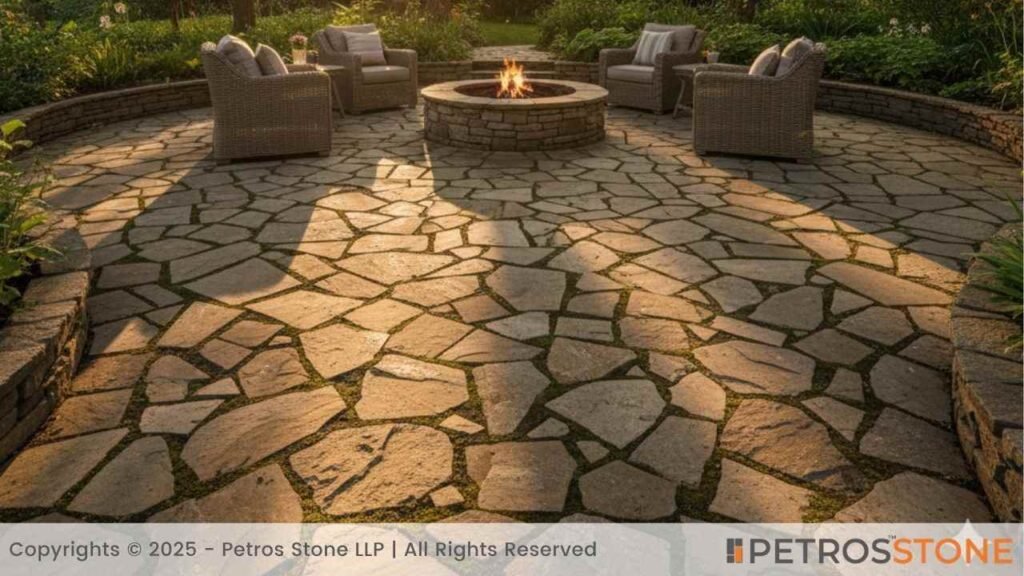
This is the most natural appearance—flagstones in various shapes and sizes stacked like jigsaw pieces with jagged edges. No grid or alignment is set. This creates an organic pattern that fits in gardens well. There are no two sections the same—giving it a very individual feel. No straight 90° corners make this pattern “crazy paving.” It works well on informal paths or patios if you want something casual and earthy. Remember that fitting irregular pieces can be tedious, but the visual payoff is huge.
Random Rectangular (Ashlar) Pattern
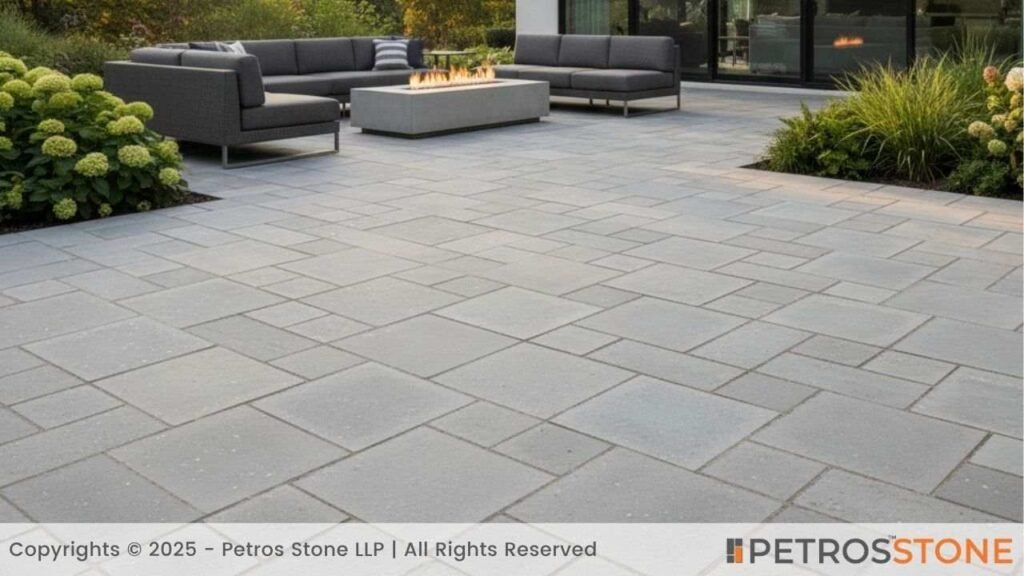
With this pattern, you place rectangular and square-cut stones of various sizes in an apparently random fashion that fit together without gaps. It’s random because the pieces are not repeated in a fixed sequence, but the edges are straight and they lock together neatly.
This ashlar pattern is very popular on flagstone patios. Generally a mixture of standard sizes (30×30 cm, 60×60 cm, 30×60 cm, etc.) is used to cover the area. The effect is formal but more dynamic than a grid. It does not point the eye in any direction (nondirectional), so it is suitable for most spaces.
Running Bond (Staggered Rows)
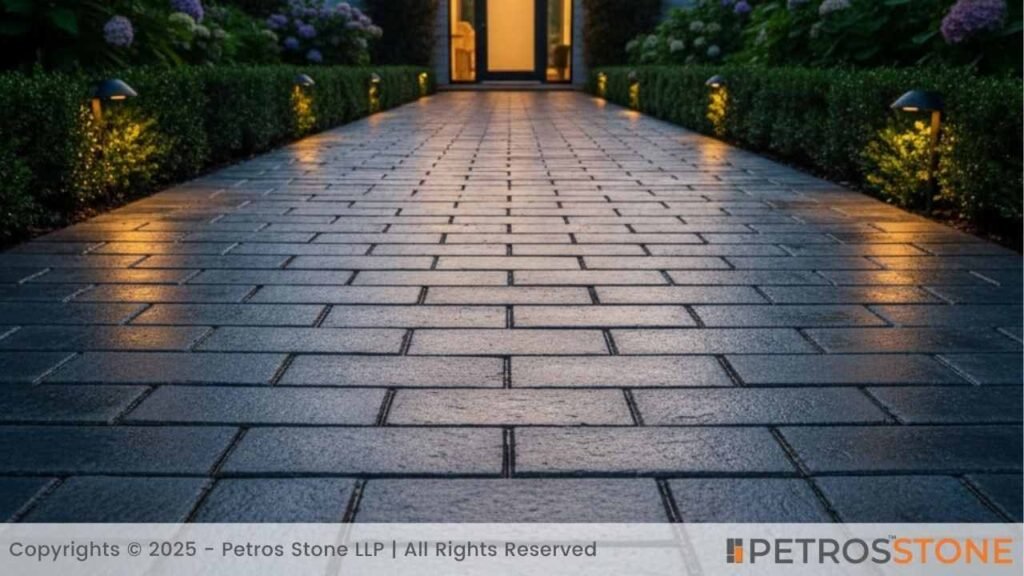
This pattern looks like a brick wall or a tiled floor – stones are set in rows, and each row is offset so that the joints stagger (the end of one stone lines up with the middle of the stone above/below it). You usually use similar-sized rectangular flagstones for this (for example, all pieces 60 cm long by 30 cm wide, laid lengthwise in rows).
A running bond gives a clean, orderly appearance yet with a bit of visual interest from the stagger. It’s considered more formal and works great if you’re aiming for a classic or contemporary look where symmetry is appreciated.
Coursed (Linear) Pattern
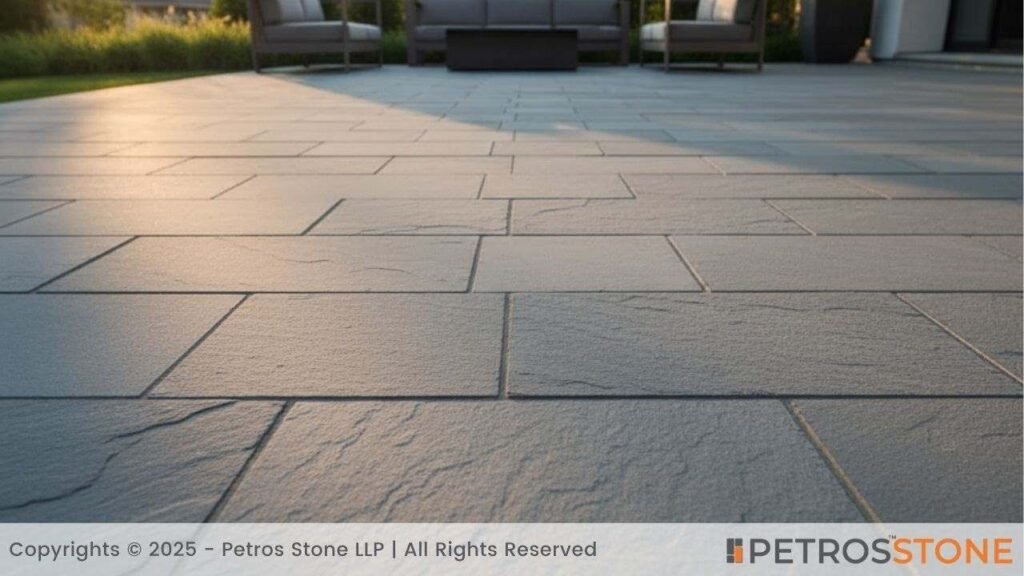
Similar to running bond, a coursed pattern involves stones laid in straight lines (courses) across the area, but you can vary the widths of the stones per course. For instance, one row might have wider pieces, the next narrower, but all stones in a single row line up in one band. The joints between rows are aligned, but joints within a row are staggered. This pattern, sometimes seen in European sidewalks, gives a linear, structured look. It leads the eye along the length of the patio or path, which can make a small space feel longer.
Geometric Cut Patterns
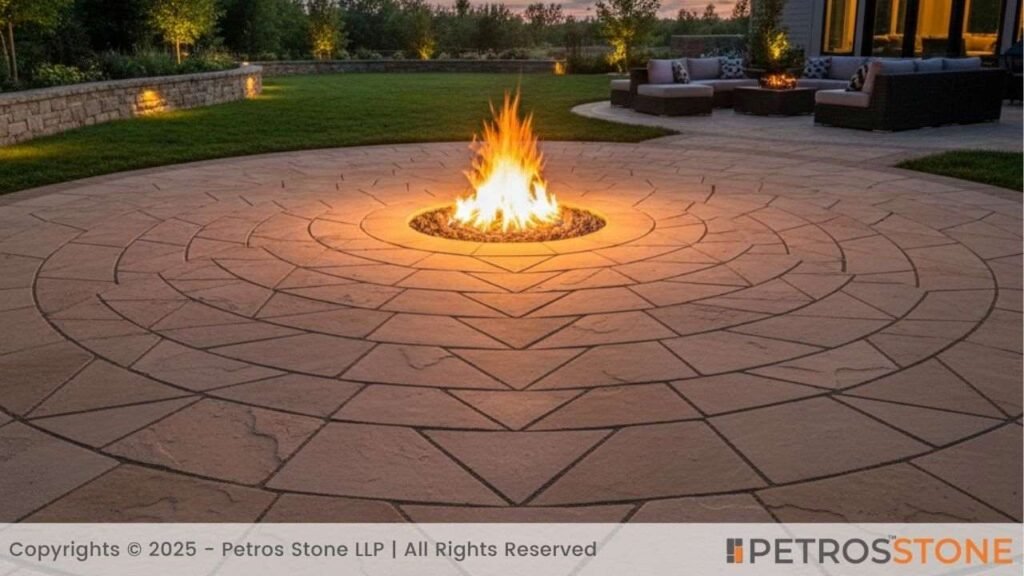
Flagstones can also be cut to specific shapes for circular or diagonal patterns. Examples include the diamond pattern—square stones laid at a 45° angle across the patio. Another is arranging stones in a circle to make a round patio or fire pit area (this may involve a combination of trapezoidal cuts or wedges). These more complicated patterns often involve additional cutting (and extra material for waste), but they can be wonderful focal points.
In either pattern, joint spacing and consistency can affect the look. Irregular patterns will have wider, variable joints (often sand, gravel, or grass planted in between), and formal patterns will have tighter, uniform joints. Pick what fits your home and garden. Not sure which pattern is right for your space? Check out Petrosstone’s article on the best stones for patios, which also includes pattern ideas and design tips for outdoor stone layouts.
Standard Sizes and How to Choose
Flagstone comes in a range of sizes and thicknesses, and picking the right size for your project is important for both aesthetics and practicality. Let’s break down the typical dimensions:
Thickness: Outdoor flagstones are usually 1 to 2 inches thick (about 25–50 mm). Thicker is generally better for durability:
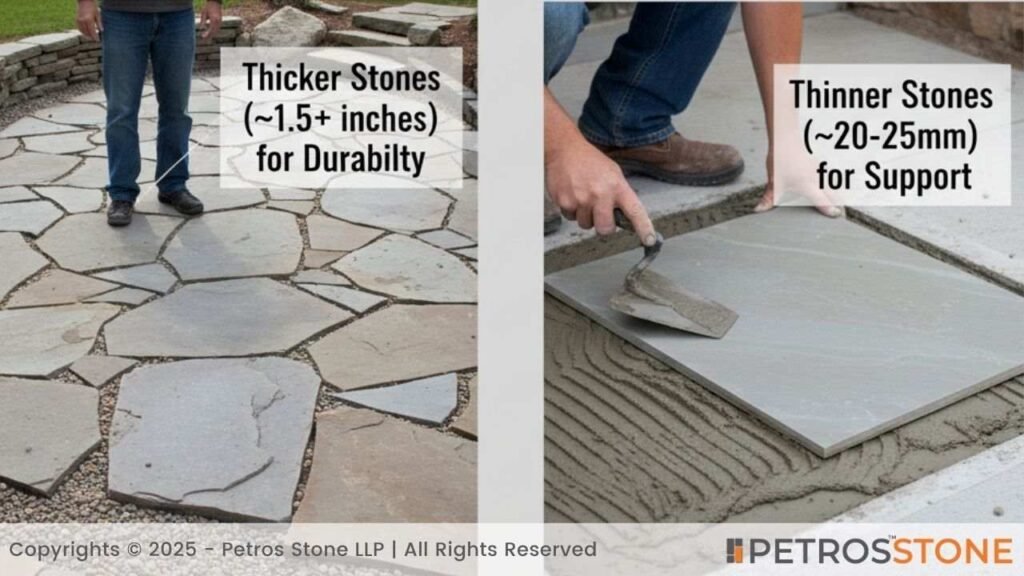
- If you’re dry-laying (on sand/gravel without mortar), go for thicker stones (at least ~1.5 inches or 35+ mm) so they won’t crack under weight. Many contractors recommend 1.5 inches (38 mm) or thicker for patios and paths that see regular foot traffic.
- If you plan to mortar the flagstone onto a concrete base, you can use thinner pieces (even 20–25 mm) because the mortar bed will support them. For instance, stones ~20 mm thick are often used on concrete patios to save cost, since the concrete provides the strength.
Length & Width: Flagstone pieces can be irregular (random dimensions) or cut into regular shapes:
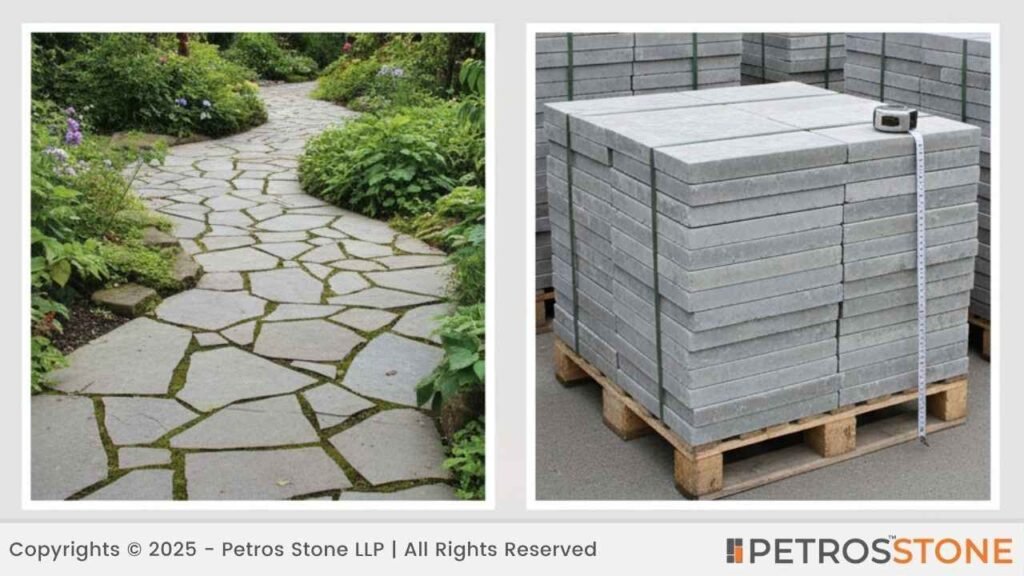
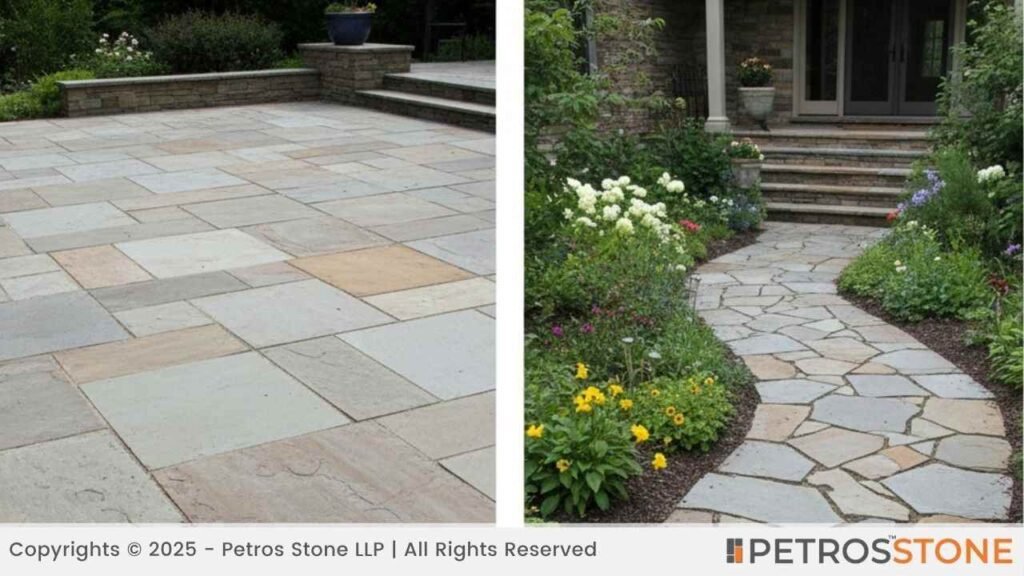
- Irregular flagstone slabs might range from about 30 cm (1 ft) across at the smallest, up to 60–90 cm (2–3 ft) across for larger pieces. These are sold by weight or area, not by exact dimensions, since each piece is unique. When choosing for a pathway, consider the size of each stone relative to footsteps – a piece that’s at least as big as an adult foot (30+ cm) is good for stepping stones.
- Cut flagstone tiles come in standard sizes. Common square or rectangular modular sizes include 30×30 cm (1×1 ft), 30×60 cm (1×2 ft), 60×60 cm (2×2 ft), 45×45 cm (1.5×1.5 ft), etc. The Robinson Flagstone company in the US, for example, lists 12 standard sizes for cut bluestone ranging from 12″ up to 24″ in increments of 6″ (approximately 30 cm to 60 cm). You’ll find similar sizing in metric (30, 45, 60 cm, etc.). Large slabs (like 90×60 cm) cover area faster and have fewer joints, great for patios, but they can be very heavy to handle.
- Flagstone pavers vs slabs: Sometimes smaller pieces (like 15×15 cm cobbles or setts) are also called flagstone, but generally flagstone implies broader slabs. Choose size based on scale of your project – a big patio can accommodate larger pieces nicely, while a small walkway might look better with medium or small pieces to keep the scale cozy.
Creative Design Ideas
Flagstone is incredibly versatile when it comes to design. It can complement a variety of architectural styles – from traditional homes to ultra-modern villas. Here are some creative ways you can use flagstone in a contemporary way:
Serene Garden Pathway
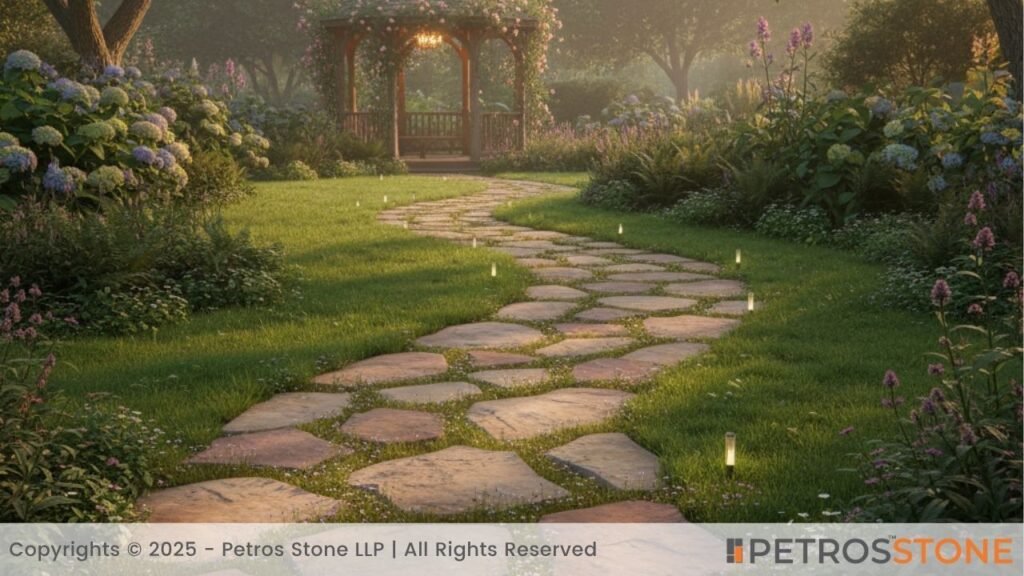
Create a meandering flagstone path through your lawn or garden. Use irregular stones spaced a few inches apart and allow grass or groundcover plants to grow between the stones for a lush, fairy-tale look. This dry-laid approach (no mortar) gives a very natural feel, almost as if the path formed over time.
It’s perfect for leading to a kitchen garden, a gazebo, or even a temple in your home’s garden. For an added romantic touch on a low-traffic path, you can let moss or small flowers fill the joints (imagine little wildflowers peeking between stones!). Just remember to use thicker stones here so they sit firmly and don’t crack underfoot.
Courtyard or Patio
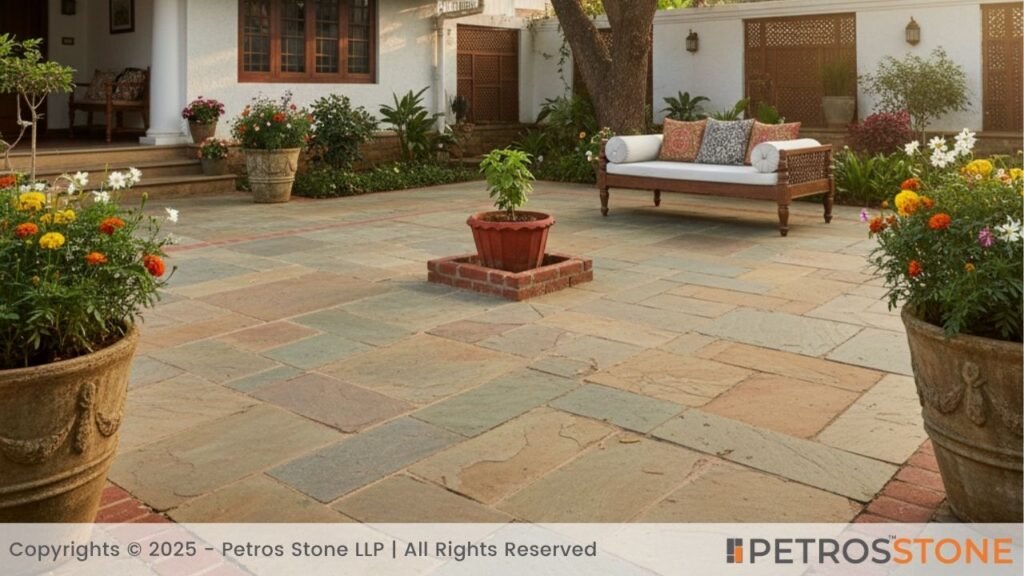
If you have a courtyard or open patio, consider flagstone flooring to instantly create a rustic vibe. Indian sandstone flagstones like Raj Green or Autumn Blend have warm tones that mimic historic courtyard floors. You could lay them in a random rectangular pattern for an old-world charm. Add planters and you have a charming courtyard.
For a fusion look, border the flagstone patio with bricks or cobbles – the contrast between brick edges and stone slabs looks lovely (for instance, a red brick border around grey sandstone flagstones). This mix is often seen in heritage bungalow gardens.
Poolside Paradise
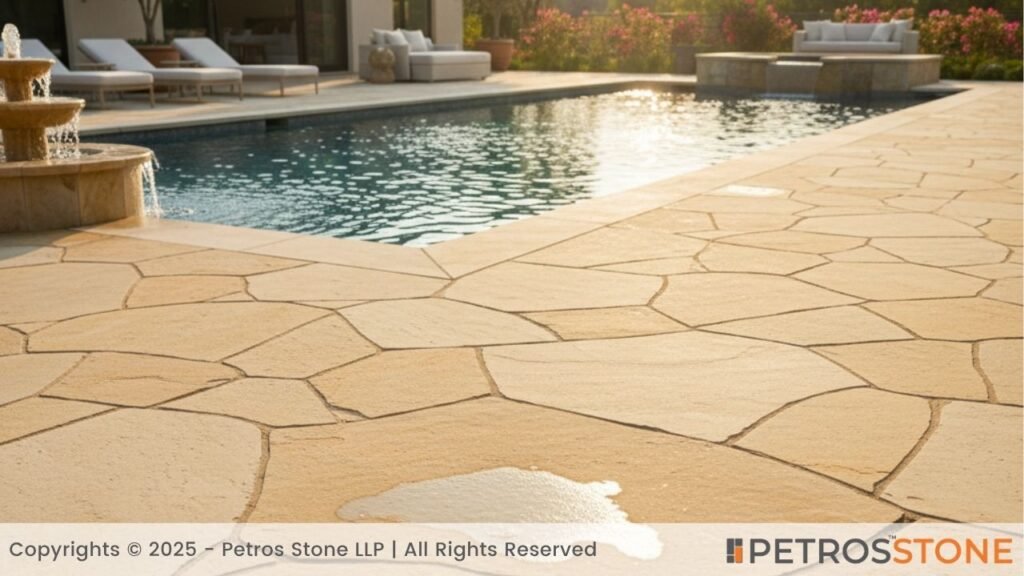
Around a swimming pool or fountain, use flagstone for the deck or coping. Stones like sandstone or quartzite stay fairly cool underfoot and have a naturally slip-resistant surface, making them practical for wet areas. A flagstone pool deck gives a resort-like feel – picture walking barefoot on smooth stone around a glistening pool. You can choose lighter colors (like tandur yellow limestone or beige sandstone) to keep the surface cooler under the hot sun.
Make sure to have the stones mortar-set for stability and consider sealing them to reduce salt/chlorine staining. The organic shape of irregular flagstones can soften the straight lines of a pool, creating a more inviting atmosphere.
Mixed-Media Mosaic
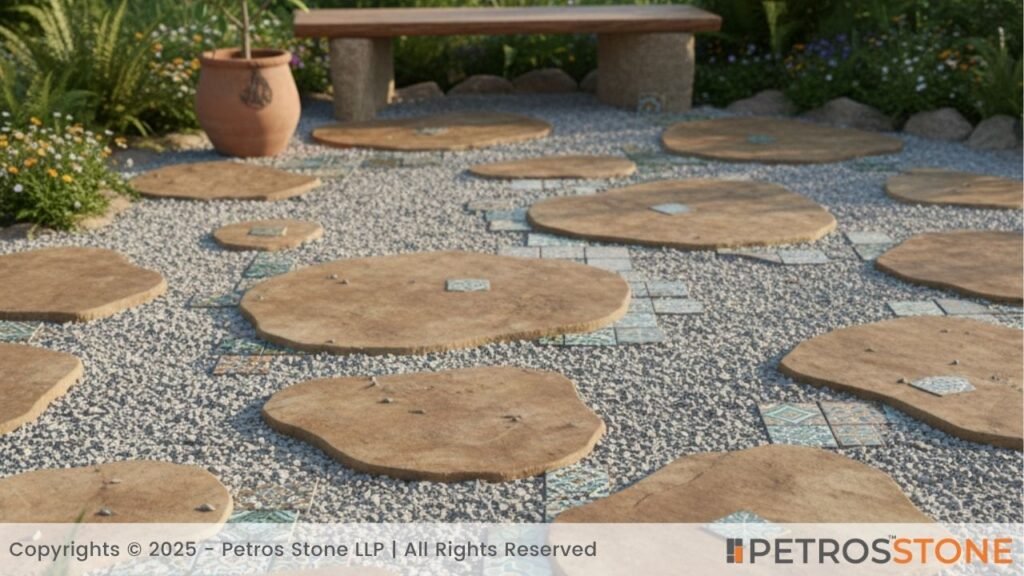
Who says you have to use only flagstone? A very creative idea is to mix flagstone with other paving materials for artistic effects. For example, combine flagstone with pebbles or gravel: you could have a few large flagstone slabs embedded in pebbles to form a zen-like garden seating area. Or use flagstone as “stepping pads” within a field of gravel or grass.
Another idea is to inlay ceramic tiles or terra cotta pieces in the flagstone joints for a burst of color (imagine a Moroccan or Rajasthani tile accent in a patio). Just be sure that any mixed materials are similarly level and durable for outdoor use.
Front Entrance Appeal
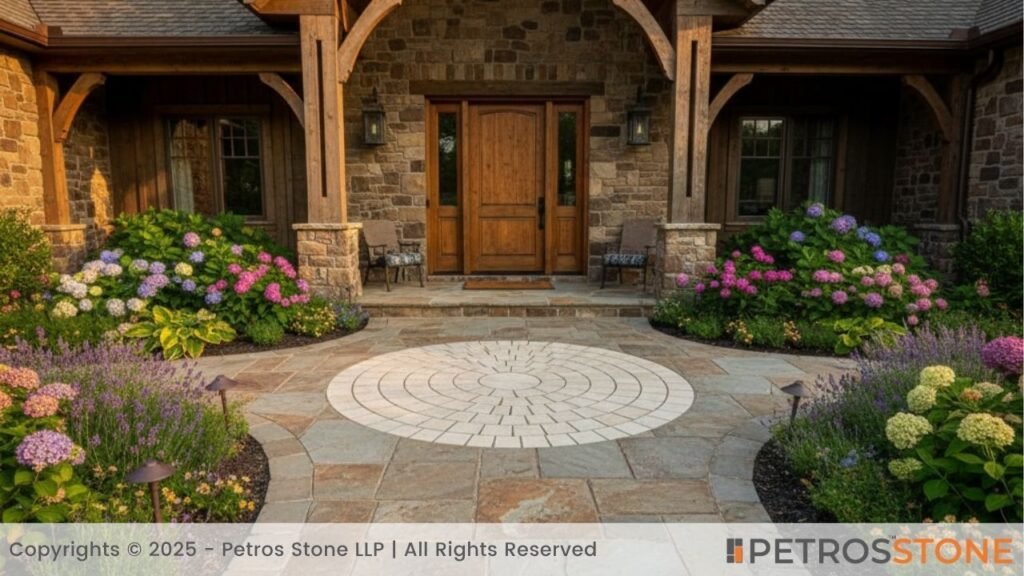
Use flagstones to build a charming front entry walkway to your main door. A curved flagstone path leading to the porch, perhaps edged with flowering plants, makes for a grand welcome. Because flagstone has an earthy look, it can pair well with both brick houses and those with plaster or stone facades.
If you want a bit of grandeur, opt for a circular flagstone landing right before the entrance – essentially a round mini-patio that can act as an entry plaza. This can be achieved by cutting flagstone pieces to form a circle (there are even pre-cut circle kits sold for paving). It adds a striking geometric feature to your landscape.
How Much Does Flagstone Cost?
Cost is a big factor in any home improvement project. The flagstone can be quite affordable in India compared to many other countries, thanks to the local stone resources. But prices vary based on the type of stone, the finish, and the installation method. Let’s break down the cost considerations:
Flagstone Cost Breakdown (USD per sq. ft.)
| Category | Details | Approx. Cost (USD / sq ft) |
|---|---|---|
| Basic Flagstone | Sandstone (Raj Green, Kandla Grey), Limestone (Kota, Tandur) | $0.60 – $1.20 |
| Premium Flagstone | Granite, Quartzite, High-quality Slate | $1.08 – $1.80 |
| Imported/Exotic | Travertine, Imported Slate, Rare Stones | $2.40+ |
| Labor – Dry-laid | Placed on sand/gravel bed, basic fitting | $0.60 – $1.20 |
| Labor – Mortar-set | Cement base, joints, skilled masonry | $1.20 – $1.80+ |
Total Project Cost Range (Material + Labor)
| Project Range | Scenario | All-in Cost (USD per sq. ft.) | Example (100 sq. ft. Patio) |
| Budget | Local stone + dry-laid install | $1.44 – $1.80 | $144 – $180 |
| Mid-range | Better stone + mortar set | $2.40 – $3.60 | $240 – $360 |
| High-end | Imported/expensive stone + intricate work | $3.60+ | $360+ |
If you’re considering flagstone (or any stone), remember that you’re not alone in this journey. Petrosstone is here to help make it easier. As a trusted supplier of premium stone in India, Petrosstone can provide you with high-quality flagstone in the colors and finishes you need.
Simple Maintenance Tips
The fact that flagstone does not require an excessive amount of upkeep is one reason many homeowners choose this flooring type. It is possible to have a lovely patio or walkway for many years with minimal maintenance. Keep your flagstone surface safe by making use of the following maintenance tips for easy care.
Cleaning
A part of the routine cleaning process. Be sure to rinse off using water right after every sweep. You can make use of a gentle soap or even a stone cleaner for deeper cleansing (do not use harsh cleaners on sandstone or limestone).
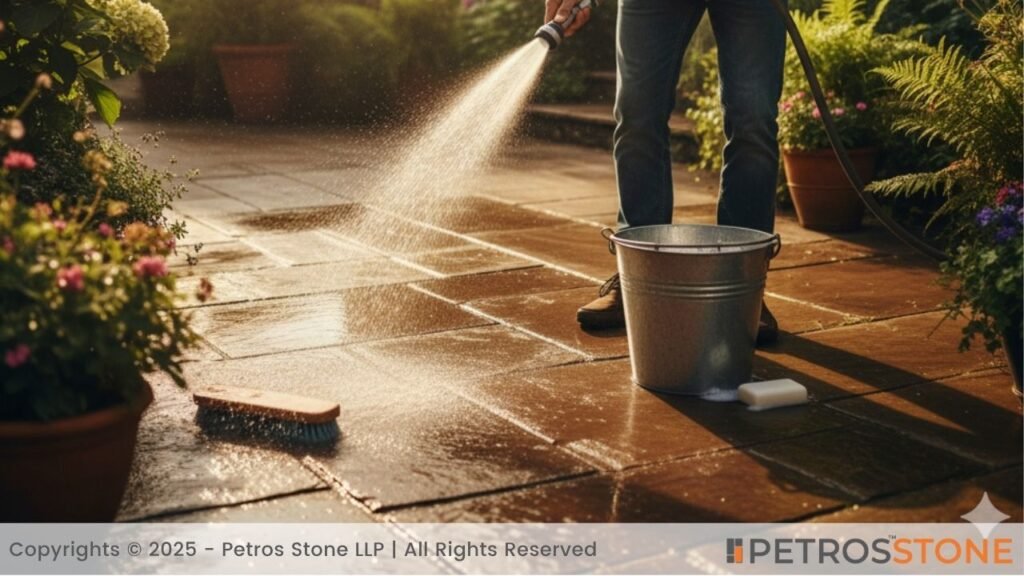
Weed and Moss Control
In the beginning of the season pull weeds, and then with a firm brush scrub the moss off. To bring down growth, keep the location dry and sunny.
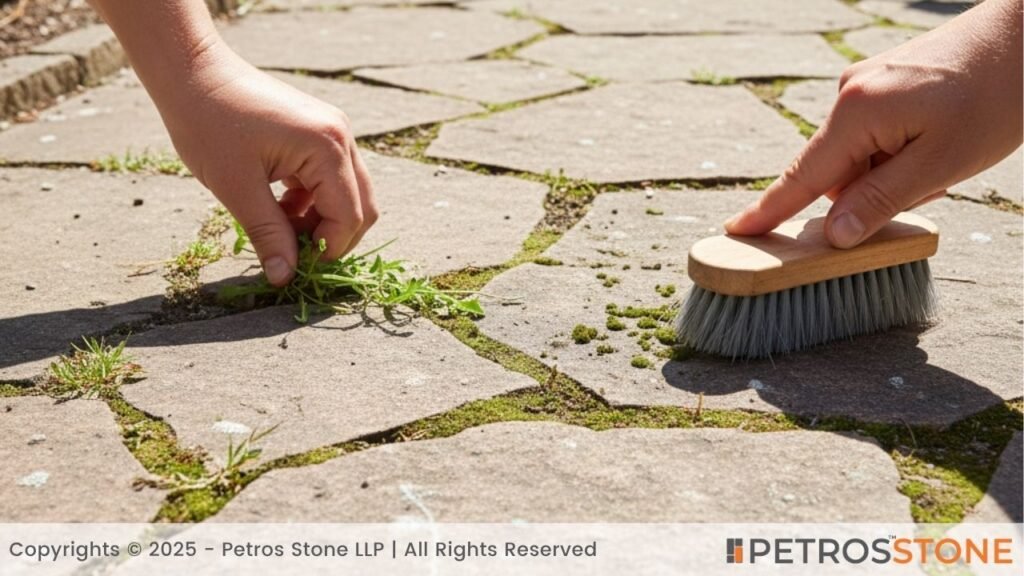
Top-Up Joints
Maintain the stones’ sturdiness and seal any holes you might have by filling in sand or gravel in dry-laid joints every year or two.
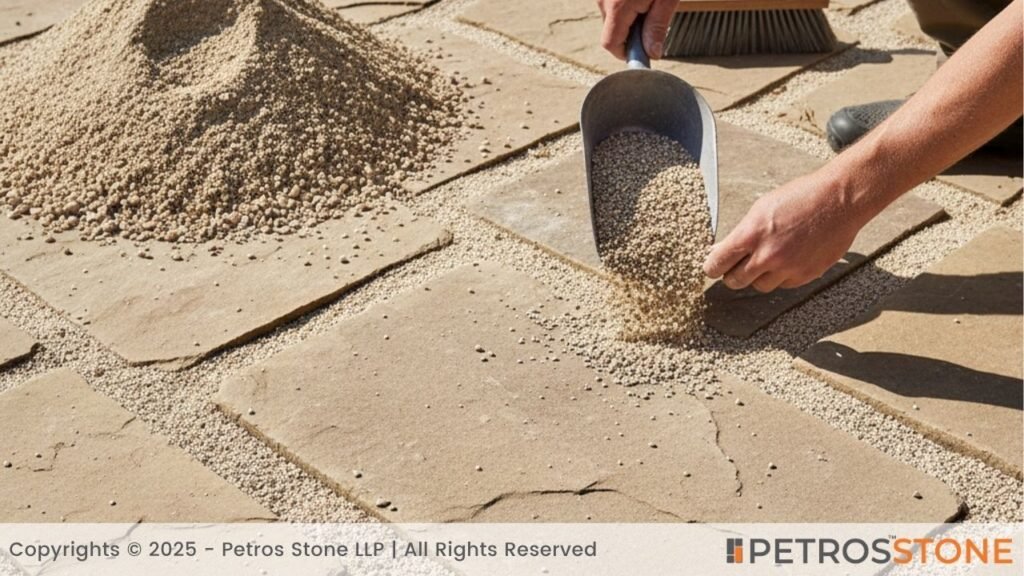
Optional Sealing
Stones such as sandstone and limestone tend to be susceptible to staining, so it’s wise to use a breathable sealer to protect them. Unless otherwise stated, replace every couple of years to make sure the seal is maintained.
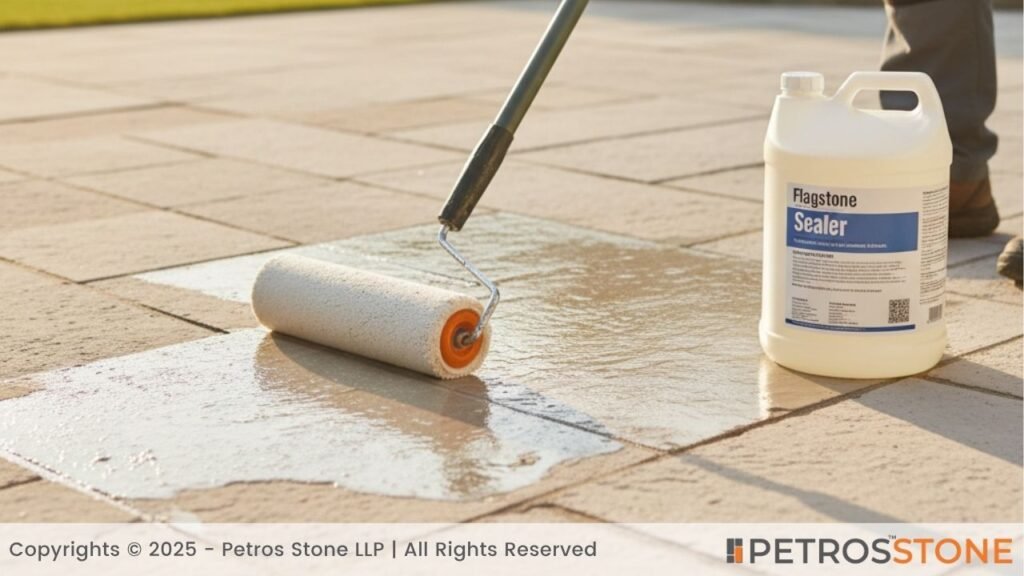
Stop the Stains
If you rinse spills off, they will rinse quickly. For oil and grease, make use of baking soda paste, and also for grilling. You are able to even use degreaser and special cleaners to get rid of rust. Keep away from stains by utilizing coasters and mats.
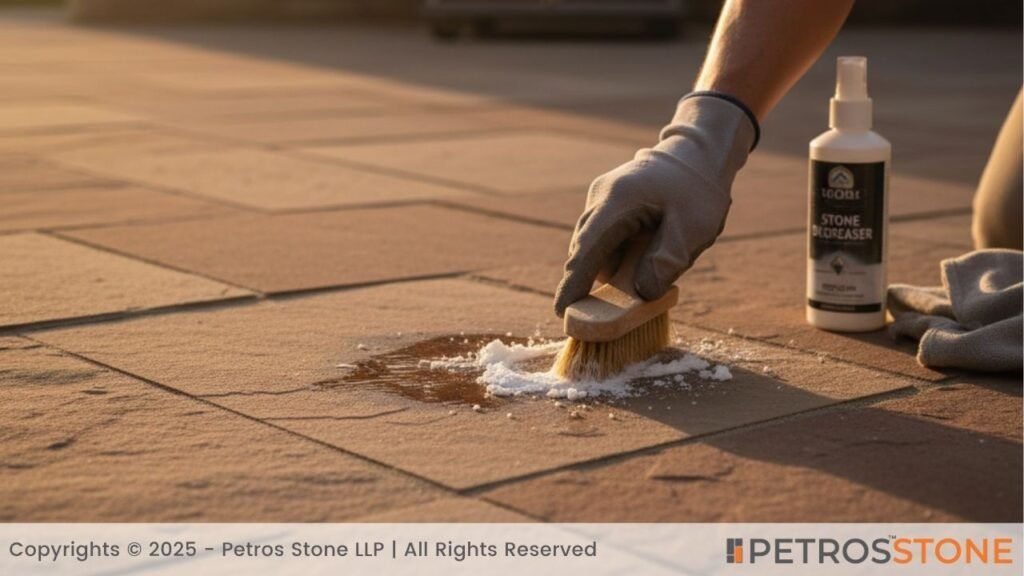
Check out and Grout
In dry-laid patios, wobbly stones ought to be releveled. In mortar-set applications, to prevent the grout from loosening, patch the cracked grout to stop it from sliding.
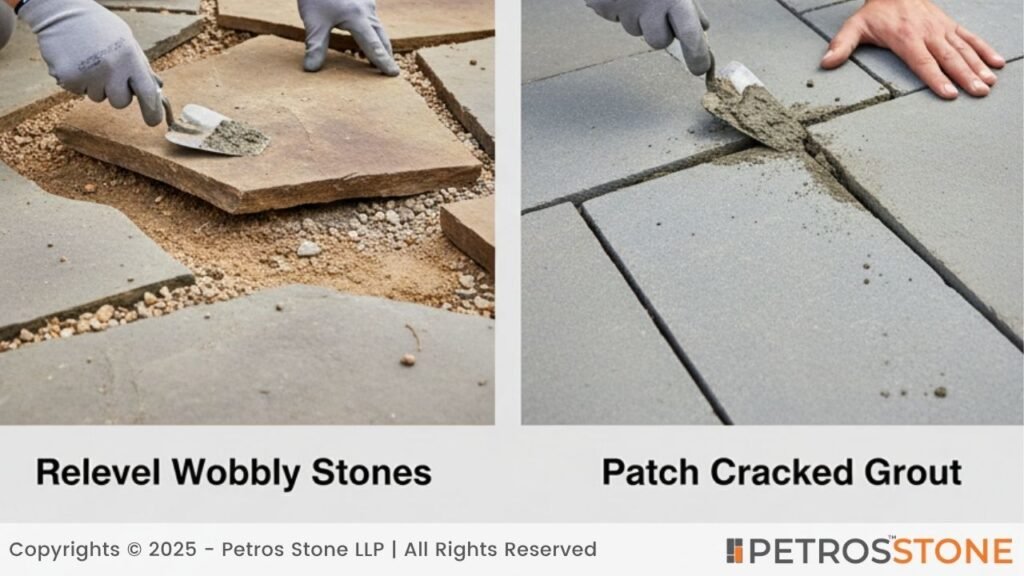
Extreme conditions call for additional protection
Don’t hammer or pull heavy furniture on the ground, and don’t allow water to freeze in cold areas.
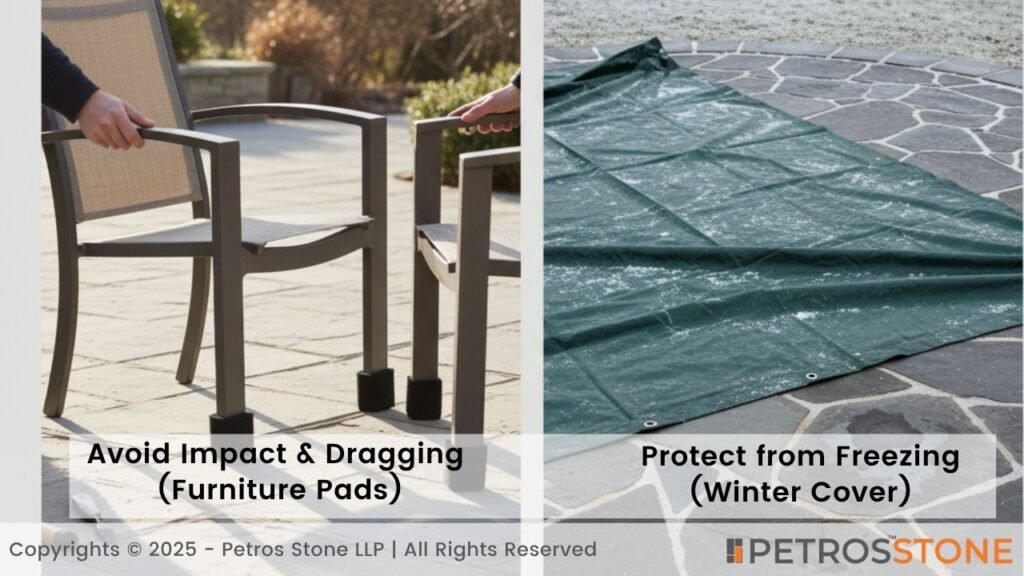
They’re fairly easy to maintain with these maintenance routines. Well-laid flagstone patios acquire character as they age (a small patina and some moderate fading of the color), which many find a lot more appealing. Your outside flagstone will certainly continue to look great if you ensure that it stays clean and take care of any minor repairs promptly.
Common Mistakes to Avoid
You will find several pitfalls to be cognizant of when carrying out a flagstone project. If you want your patio or pathway to be aesthetically pleasing, avoid these common mistakes made by home improvement experts.
- Skipping Base Prep: You need to never place stones on the ground directly. Apply sand or even gravel on the gravel base and compact it more.
- Making Stones Too Thin: Cracking is not hard with stones below 25-30 mm. Use caution when working with thin slate or shale. Be sure you select paving stones that are durable.
- Drainage Must Be Considered: Always use a grade of 1-2% for runoff from the surface area. When you have flat patios, it is easy to get puddles and joints to swim in.
- Bad Joint Spacing: Do not leave extremely broad gaps or cram stones too tightly. Be sure your joints are consistent and practical.
- Random Pattern Done Wrong: Something random has to be planned. To prevent odd repetitions, mix the sizes equally and break the joint lines.
- DIY Tips for Big Projects: DIY projects are okay for little garden paths. Work with a specialist to carry out any major rework, such as rooftops or patios.
‘Low maintenance ≠ No maintenance. Even though flagstone is easy to maintain, that doesn’t mean you can completely ignore it. A couple of times a year, search for weeds, loose stones, or any marks.
You must avoid these typical blunders if you want a project that turns out beautifully and runs smoothly. Doing your homework, consulting experts when necessary, and dedicating extra time to the design and preparation are the keys to successful flagstone projects.
Summary
Flagstone is one of those materials that manages to be both rustic and elegant, both down-to-earth and uniquely stylish. It brings a slice of natural landscape right to your doorstep, be it through a winding garden path or a cozy patio floor for weekend barbecues. We’ve explored what flagstone is, how you can lay it in different patterns, how to choose the right pieces, and even how to take care of it. By now, you hopefully have a clear picture of how flagstone can enhance your home’s outdoor living spaces.
A few parting tips: plan well, choose quality materials, and don’t rush the installation. The charm of flagstone is in its irregularities and natural feel, so even if every stone isn’t cut perfectly, it will still look beautiful as a whole when thoughtfully composed. Embrace the process—designing your pattern, seeing the stones come together – it’s genuinely enjoyable. And once it’s done, flagstone ages gracefully; minor weathering often just adds to the character.
FAQs
Q: What’s the best pattern for a small garden path?
Irregular flagstone (“crazy paving”) is ideal for natural, meandering garden paths.
Q: How thick should flagstone be for patios?
At least 1.5–2 inches for dry-laid patios; thicker stones for driveways and pool decks.
Q: Do I need to seal flagstone?
Most types benefit from annual sealing, especially in harsh climates and high-traffic areas.
Q: How do I calculate the amount of flagstone needed?
Measure total area (sq. ft.), divide by coverage per ton (based on stone thickness), and add 5–25% for waste.
Key Takeaways
- Flagstone offers timeless, natural charm perfect for patios, walkways, garden paths, and pool decks, blending rustic appeal with durability and slip resistance.
- Popular patterns include irregular crazy paving, random rectangular ashlar, running bond, coursed linear layouts, and geometric cuts—each creating a unique outdoor aesthetic.
- Sizes and thicknesses vary, with thicker slabs (1.5–2 inches) recommended for dry-lay paths, and thinner stones usable on mortar-set surfaces for cost savings.
- Creative applications in Indian homes include serene garden paths, rustic courtyards, poolside decks, and mosaic-style designs mixing tiles, gravel, or pebbles.
- Proper installation and maintenance are key—avoid common mistakes like thin stones or poor drainage, and follow simple upkeep like sealing, weeding, and joint filling.
Feel free to get in touch for a free consultation, quote, and get a detailed understanding from our experts here at Petros®. Visit https://petrosstone.com/ or call +91-8446360361 and WhatsApp

Hi, I’m Dhananjay,
With a background in architecture and years of industry experience, I share insights on materials that shape great design. At Petros® Stone, I craft content that highlights the beauty and utility of natural stone, helping architects, builders, and homeowners make informed choices while strengthening the brand’s voice and online presence.
Brown Granite
White Galaxy Granite
Blue Bahia Granite
Silver Cloud Granite
Black Pearl Granite
Dallas White Granite


